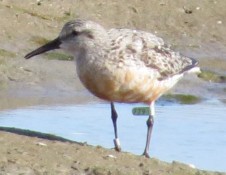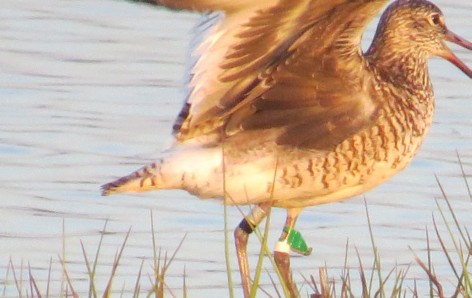Dave Adrien

Figure 1. Leg bands on Herring Gull 148. All photographs by the author.
Reset the calendar to July 2014, which coincidentally aligned with gull post-nesting dispersal for the year. The seasonal lull had set in. Spring warbler migration had ended and shorebirds had yet to head south. I asked a simple question of Sue McGrath of Newburyport Birders: “I’m accumulating some pictures and sightings of gulls on Plum Island. Where, or to whom, do I report these sightings?” The response was prompt. Sue told me to contact Julie Ellis, the director of the Gulls of Appledore program. As it turned out, Professor Ellis was on maternity leave so I struck it up with longtime volunteer Bill Clark.
A birder in New Hampshire questioned me one day about what I was doing as I was taking pictures of gulls on Hampton Beach. When I explained, his comment was: “We don’t pay attention to banded gulls. They are all from Appledore.” Well, not exactly.


Figures 2 & 3. Great Black-backed Gull 2E2 with mate (left). Great Black-backed Gull 2E2 with offspring (right).
If you have spent any time on the Parker River National Wildlife Refuge or on Sandy Point State Reservation then you, too, have probably run into Great Black-backed Gull (Larus marinus) 2E2. Gull 2E2 was banded as a nesting adult on Appledore in May 2006, so he is at least 14 years old now. He is a regular and we have proven him to be a commuter to the Isle of Shoals as we have sightings on Plum Island and his nest site on Appledore in the same day. Gull 2E2 often returns to the refuge in late March or early April with his assumed mate (see Figure 2). Then he makes lone cameo appearances during the nesting season. In early August he shows up with his offspring (see Figure 3), only to disappear in late December.


Figures 4 & 5. Ring-billed Gull K41 (left). Herring Gull 148 (right).
Wandering west on Sandy Point, you will find a typical roost of gulls where you might see Ring-billed Gull (Larus delawarensis) K41 (see Figure 4). He typically shows up in late July. Gull K41 was banded in Varennes, Quebec, on Ile Deslauriers in the St. Lawrence River.
If you move farther north along Plum Island you will find another regular banded gull on the beach at Parking Lot 1. Herring Gull (Larus argentatus) 148 (patagial tag -see Figure 5) with an orange color band #19 (see Figure 5) was banded by the Massachusetts Department of Conservation and Recreation (DCR) on Revere Beach as a juvenile on December 20, 2012. He has become an adept camp raider, and pity the poor fisherman who left an unguarded bait bucket only to return to find it empty.
I see one gull every winter that returns to shop at Walmart on Route 1 in Seabrook, New Hampshire. Herring Gull ALY (see Figure 6) was banded on July 5, 2014, on Brier Island, Nova Scotia at the tip of Digby Neck, and frequents the parking lot here between January and February. That pink band really stands out.


Figures 6 & 7. Herring Gull ALY (left). Herring Gull X53 (right).
My long-distance gull winner is Herring Gull X53 (patagial -see Figure 7) with a burnt orange color band TG. Gull X53 was banded in Witless Bay, Newfoundland on September 9, 2012. Talk about site fidelity, this gull returns to Revere Beach in front of Kell’s Kreme, and I have located it here for 3 years within 100 yards of shorefront every year.

Figure 8. Ring-billed Gull 724-20656.
If you find that reading the plastic field readable (PFR) bands is too easy then you can search for gulls that have only a metal band. It takes a little patience to get all nine numbers but sometimes it can prove interesting. Ring-billed Gull 724-20656 (Figure 8) was found on the Exeter River in downtown Exeter, N.H. on February 22, 2016. This was the first reported sighting of this bird that was banded in Quebec City, Quebec on June 2, 1993. At 23 years old, this bird has won my known age contest; it was likely banded as an adult, which could add another three years.


Figures 9 & 10. Hybrid Gull F07 (left). Herring Gull N72 (right).
I hope I have shown that not all banded gulls come from the Maine colony and that almost every gull has a unique story, including Herring Gulls raised by Great Black-backs, not to mention hybrids.
Gull F07 (see Figure 9) is a well documented cross between a Lesser Black-backed Gull (Larus fuscus) and a Herring Gull on Appledore. Herring Gull N72 (see Figure 10) was banded in July 2008 and the gull team made a strange observation. Great Black-backed Gulls were feeding, raising, and defending this Herring Gull chick. This was unusual as Great Black-backs often kill and eat young Herring Gulls. This pair of Great Black-backed gulls was also suspect in consuming eggs from nearby Herring Gull nests. Somehow this Herring Gull chick survived and was adopted by the Great Black-backed pair. The one re-sight in 2013 indicated that N72 had survived to adulthood. The photo above is from the only set of pictures of N72. Based on the surrounding birds, N72 does realize he is a Herring Gull and is tolerated by his peers.
But the real thrill comes when you find the unexpected, be it a Black-headed Gull (Chroicocephalus ridibundus ) on Hampton Beach, Hampton, New Hampshire or a Little Gull (Hydrocoloeus minutus) on Sandy Point, Ipswich, Massachusetts (7/13/2015—see Photo Essay).
My search for bands has proven a number of things:
Here is a birding activity that can be done in the dead of winter. Nothing is more fun than Revere Beach at -2° F with a 20–30 mile per hour wind.
You can provide volumes of information to researchers. I now regularly correspond with eight different agencies in four states and four provinces in Canada on gulls alone.
But the biggest benefit is that unknowingly you slow down and look at every bird, and when you are frequenting the beaches you find numerous other specialties.


Figures 11 & 12. American Oystercatcher (25) (left). Red Knot (779) (right).
It could be an American Oystercatcher (Haematopus palliatus) (band #25—see Figure 11) that commutes to Cedar Key, Florida or a Red Knot (Calidris canutus) (lime green flag # 779—see Figure 12) that shows up at Mispillion Harbor, Delaware in May every year since 2010.

Figure 13. Semipalmated Sandpiper with geolocator.
The Semipalmated Sandpiper (Calidris pusilla) (see Figure 13) was one of 29 birds outfitted with geolocators on Coats Island, Nunavut, Canada, in June of 2015 by Shiloh Schulte from Manomet. It showed up at Sandy Point on August 12, 2015. In late July 2016, I managed to find two blue-flagged Semipalmated Sandpipers on Sandy Point. They were originally banded in Coroa dos Ovos, Maranhao, Brazil.
In May 2016, Dave Williams, a Mass Audubon volunteer, asked me if I had seen the banded Willet (Tringa semipalmata) at the Pannes. Well, I couldn’t let that go by. Eventually I found six Willets that had been banded in 2015 by the Biodiversity Research Institute (BRI). These birds were equipped with geolocators as well. Geolocators are great and relatively inexpensive, but they are archival. They do not transmit. Thus, recapture is necessary to retrieve the data. On May 26, I photographed one bird (Figure 14) with its geolocator in place, and I saw it again on June 3. It was recaptured on June 22 and the geolocator was gone. This bird had been to Brazil and back only to lose all of its recorded data out on the Plum Island marsh. According to Kevin Regan, lead investigator for BRI, “Twenty-two of twenty-five willets banded in the Gulf of Maine and in New Jersey wintered in Maranhoa, Brazil, indicating this species may have a very limited wintering range, making these birds even more vulnerable to degradation of those habitats.” They have a fascinating migration route. Willets fly four to six days out over the open Atlantic from Massachusetts to South America, and return across Cuba and up the Eastern Seaboard.

Figure 14. Willet
In July 2016, I was doing re-sights on terns at Sandy Point. I managed to find many birds—both adults and hatch year of Common as well as Roseate terns. I found two yellow-flagged Common Terns that were tagged in Argentina. Needless to say, they have won the distance contest. The adventure never ends.
To get back to the original topic of the story, my banded gull count now stands at 644 birds with over 2250 sightings. So, go out and give it a try. You never know what fascinating people you will meet or what birds you might find.
Good birding.
Reference
Dave Adrien retired from the lumber business in June 2014 and has been a full-time birder since. Most weekdays he can generally be found somewhere on Plum island.